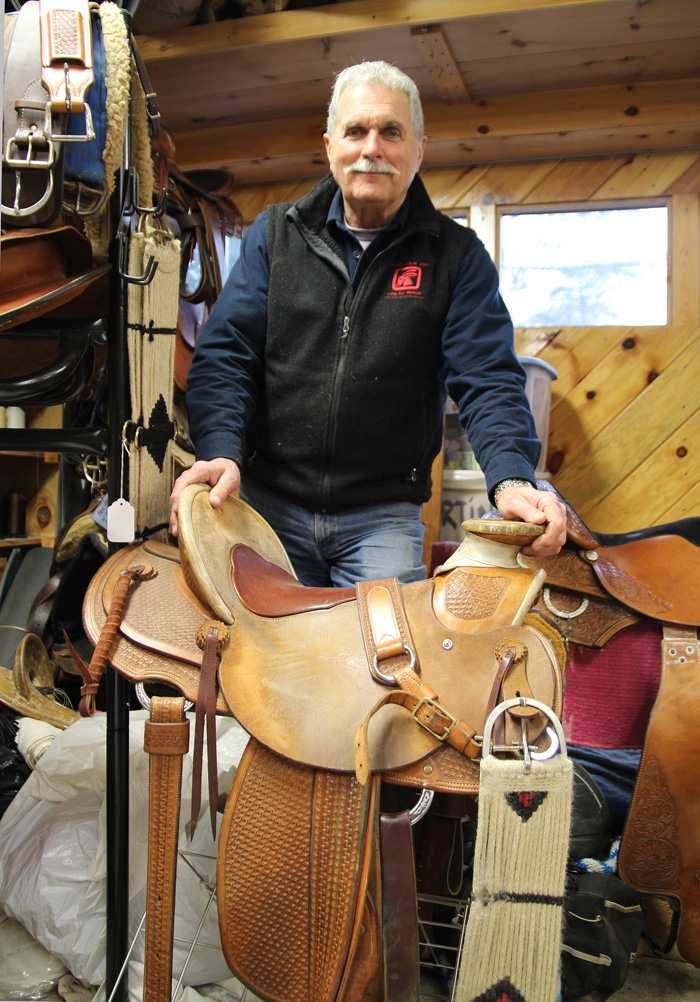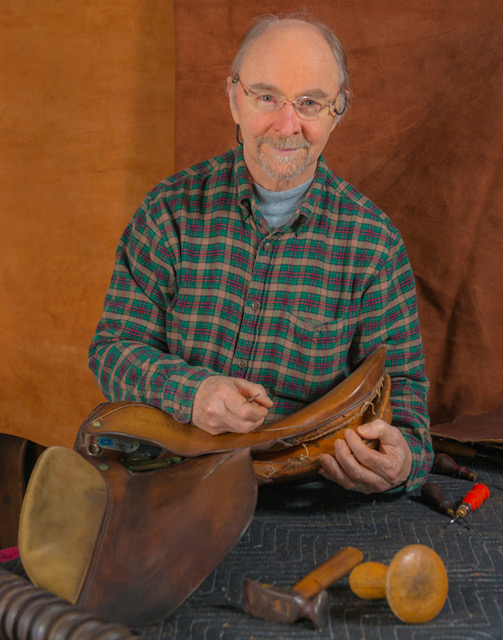Festival season is upon us once again. We have a wonderful line-up of craft artists who will be demonstrating at this summer’s Lowell Folk Festival. This year’s folklife area features individuals whose work has tangible ties to land or sea, for example, market baskets woven from homegrown willow, Native wampum forged from locally harvested quahog shells, and yarn spun from the fleece of grazing sheep. Craft traditions evolve from the human response to utilitarian needs and the quest for beauty. A hand-crafted wooden ship’s wheel with its polished brass hub looks beautiful and feels good in the hand.
In this post, we introduce you to three crafts people whose work is related in some way to horse fittings. Did you ever wonder how leather is formed into lasting saddles that benefit both rider and horse? Do you know how a western saddle differs from an English saddle? And what about keeping flies off of horses?
Horseback riders in eastern Massachusetts predominantly ride English style, while those in the western part of the state favor western saddles. Lucky for them, they can rely on the craftsmanship of Keith LaRiviere of Orange, Massachusetts, who may be the only western saddle and tack maker in New England. LaRiviere is a parachute rigger by training with 37 years’ experience as a skydiving jump instructor, parachute rigger, and jump pilot. So why saddles? Blame his wife Jane’s need for repair of her horse tack, says Keith. His familiarity with repairing parachuting harnesses led to his slowly accumulating the tools and skills to work on leather horse tack. “I started out small, basically doing repairs and making headstalls and bridles, chaps and chinks.”
Inspired, Keith went on to study saddle making with Colorado saddler Jesse Smith and apprentice with New Hampshire harness maker Russ Bigelow. The apprenticeship was a chance to build a show harness for a draft horse and a replica of an 1859 saddle, the one used by US Cavalry during the Civil War. In addition to the two to three saddles he builds a year, Keith repairs old ones with tender loving care. Beyond saddles, Keith has made or fitted several pieces for Civil War reenactors, created harmonica cases, tool cases, and holsters for modern cowboy mounted shooters.
Tony Cooper of Royalston, Massachusetts has been making, fitting, and repairing saddles since 1984. A native of Dublin, Ireland, he received his training in leatherwork at Cordwainers College, London, where he focused on rural saddlery. Tony completed his saddlery training, was elected to the Guild of Master Craftsmen, and returned to New England and started knocking on barn doors.
A proper saddle gives support to the rider, while distributing the rider’s weight on the horse. If the horse is comfortable under the saddle, it moves more freely, enabling horse and rider to perform optimally as a single unit. “I contour the bottom of the English saddle to fit the horse’s shape.”
In addition to making a saddle from scratch, much of Tony’s time is spent refurbishing, replacing, or rebuilding all parts of a saddle. This can involve re-stuffing panels and converting felt and foam panels to wool; replacing worn seats, skirts, knee rolls, billets and flaps; enlarging panels by adding gussets; and adjusting and repairing trees, the wooden framework of the saddle. Tony likes that there are certain parts of saddle making that must be done by hand. Like sewing – using an awl to punch holes, he sews 12 stitches to the inch, just like a skilled quilter.

Barbara Merry of Wakefield, Rhode Island excels in the maritime tradition of knot tying, fashioning rope into nautical fenders, beckets (decorative rope handles), and other useful marine lines. She recently revived the art of making Victorian-style horse fly blankets, which were once used solely for the purpose of keeping biting flies off horses.
Today, some kind of blanket remains in demand, particularly among discriminating horse owners who choose not to use petroleum-based fly repellent on their animals. Called “swish” blankets and made of nylon, these blankets are woven in two sizes (draft horse and buggy horse). Back in the early 1800s, the material of choice was strips of leather stitched together. In time, the blankets “morphed” into ornate objects, beautifully knotted in natural fiber cordage.
Women excelled at this type of work. It was usually done by wives, sweethearts, and daughters after finishing or repairing nets for their fisherman. It was only natural that these women would turn this skill to the manufacture of horse fly blankets for customers in New York, Philadelphia, and Boston — big cities where there were a lot of flies!
All three craft artists will be demonstrating in the Folklife area of the Lowell Folk Festival this July 29 and 30, 2017.
Maggie Holtzberg manages the Folk Arts & Heritage Program at Mass Cultural Council.




